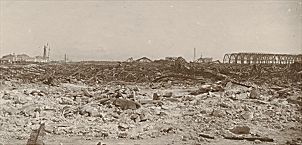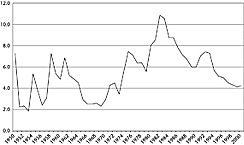| Entries |
| U |
|
Unemployment
|
Great turbulence, marked by periods of economic dislocation and grassroots movements for social insurance programs, has characterized Chicago's unemployment history. In 1819, Illinois enacted poor laws that provided for overseers of the poor. However, recurrent panics brought unemployment and poverty so severe as to require municipal attention. In the depression of 1857, 20,000 Chicago workers and their dependents faced starvation, and relief was inadequate. On Christmas Day, in the depression year of 1873, police dispersed crowds of unemployed begging for food at the Relief and Aid Society.

|
In 1899, Illinois became the fifth state to establish a State Employment Service. Compulsory unemployment insurance became an objective of reformers. A committee at the University of Chicago sponsored by the American Association for Labor Legislation called in 1912 for a state or national unemployment insurance program.
Labor's agitation for the abolition of unemployment was the strongest in Illinois, where the Illinois Federation of Labor and the powerful Chicago Federation of Labor, under the progressive leadership of John Fitzpatrick, formed the core for a local, state, and national labor party movement. In the spring of 1919, Chicago leaders ran state and local tickets on a reform manifesto called “Labor's Fourteen Points,” which demanded full pay for the jobless and comprehensive social insurance.
Unions also attempted to set up their own system of unemployment insurance between 1919 and 1928, as the Amalgamated Clothing Workers of America and the International Ladies' Garment Workers' Union adopted progressive unemployment insurance plans. The depression of 1920–22 terminated these “Chicago Plan” developments, but the unions managed to pay reduced unemployment insurance through the mid-1930s.

|
Despite this burgeoning right-to-work movement, there was no nationwide organization of the unemployed until April 1936, when the Workers Alliance of America was formed, merging with the Unemployed Council, the Unemployed League, and some independent organizations. The alliance's protest activities served to support increased appropriations for the New Deal's work programs, such as the Works Progress Administration (WPA), created by executive order of the president on May 6, 1935.
The Wagner-Peyser Act (1933) established the federal-state system of public employment services and the Veterans' Employment Service. The Social Security Act of 1935 mandated unemployment insurance in the United States. Illinois was the last state to adopt the unemployment insurance law in 1937.

|
The Encyclopedia of Chicago © 2004 The Newberry Library. All Rights Reserved. Portions are copyrighted by other institutions and individuals. Additional information on copyright and permissions.